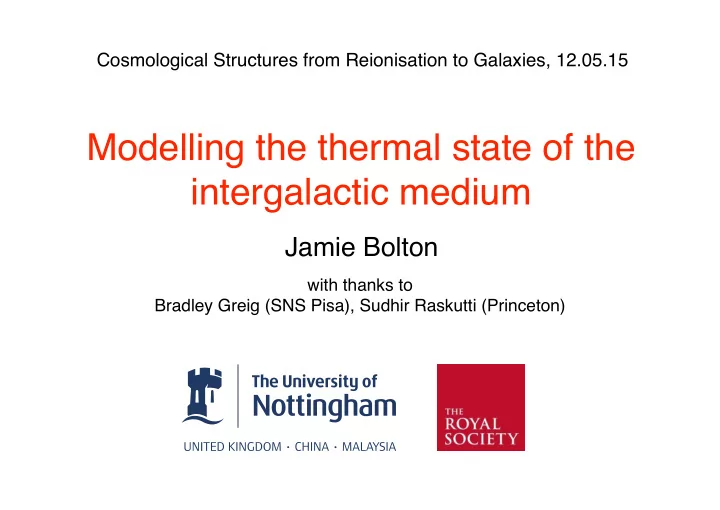

Cosmological Structures from Reionisation to Galaxies, 12.05.15 Modelling the thermal state of the intergalactic medium Jamie Bolton with thanks to � Bradley Greig (SNS Pisa), Sudhir Raskutti (Princeton)
Motivation • IGM contains majority of baryons in the Universe during reionisation and “galaxy formation” era; � � • (Post-reionisation) thermal state of IGM is indirect probe of the timing of reionisation and properties of first sources; � � • Important nuisance parameter when extracting cosmological parameters from the Ly- α forest.
Photo-ionisation heating e- H + E > 13.6 eV photon Ejected photo-electrons share their energy with neutrals via scattering and raise the temperature of the residual H-I.
The Ly- α forest as a thermometer Becker et al. (2011) 1) Thermal broadening by instantaneous temperature (along the line of sight only); � 2) Jeans smoothing via integrated heating history (in three dimensions).
Photo-ionisation heating Low density ( Δ <10), highly ionised IGM in photo-ionisation equilibrium 2 dT dt = h E i α ( T ) n � 2 HT 3 k B Miralda-Escudé & Rees (1994)
Photo-ionisation heating Low density ( Δ <10), highly ionised IGM in photo-ionisation equilibrium 2 dT dt = h E i α ( T ) n � 2 HT 3 k B Miralda-Escudé & Rees (1994) J ν ∝ ν − β Optically thin IGM, power-law spectrum for UV background: h ν i h E i = β + 2 Abel & Haehnelt (1999)
• Hydrodynamical IGM simulations James Bolton (Nottingham) � with P-Gadget-3; � Martin Haehnelt (Cambridge) � � Avery Meiksin (Edinburgh) � • 15 million hours Frazer Pearce (Nottingham) � Ewald Puchwein (Cambridge) � on Curie through John Regan (Helsinki) � PRACE; � Debora Sijacki (Cambridge) � Matteo Viel (Trieste) � • 40-160 Mpc/h boxes, 2x2048 3 particles; � � • Planck-1 cosmology; � � • Designed for studying the IGM approaching reionisation.
• Hydrodynamical IGM simulations James Bolton (Nottingham) � with P-Gadget-3; � Martin Haehnelt (Cambridge) � � Avery Meiksin (Edinburgh) � • 15 million hours Frazer Pearce (Nottingham) � Ewald Puchwein (Cambridge) � on Curie through John Regan (Helsinki) � PRACE; � Debora Sijacki (Cambridge) � Matteo Viel (Trieste) � • 40-160 Mpc/h boxes, 2x2048 3 particles; � � • Planck-1 cosmology; � � • Designed for studying the IGM approaching reionisation.
The temperature-density relation Optically thin IGM, power-law relationship between temperature and density, γ ~1.0-1.6 e.g. Hui & Gnedin (1997) T = T 0 (1 + δ ) γ − 1
Additional effects during reionisation 1) Patchy ionisation and heating: regions far from sources are heated last, have less time to cool. Trac, Cen & Loeb (2008)
Additional effects during reionisation 2) Spectral filtering: hard photons have longer mfp, average <E> larger ahead of ionisation front. Meiksin & Tittley (2012) � see also Abel & Haehnelt (1999)
The temperature-density relation Inhomogeneous heating and spectral filtering will induce scatter in the temperature-density relation (H-I and He-II reionisation) z=9 Compostella et al. (2013) Ciardi et al. (2012)
“Semi numerical” approach � • Patchy reionisation on large scales L~100 Mpc/h, f coll (R)> ξ -1 ; � � • Calibrate emissivity in ionised regions to match CMB and Ly- α forest data; � � • Ionisation and heating from emissivity & mean free path. Geil & Wyithe (2007)
“Semi numerical” approach Raskutti et al. (2012) � see also Lidz & Malloy (2014)
Application: IGM temperature at z~6 Keck/ESI, shown at R~1800 Fan et al. (2006) SDSS J0818+1722 Keck/HIRES, R~40,000 Becker et al. (2007)
Application: IGM temperature at z~6 • Temperature data WMAP+Ly- α forest inconsistent with very late end to reionisation, z<6.5; � � • Limited constraining power at higher redshift due to z~6 temperature thermal asymptote; � � • Model dependent: harder sources favour earlier end to reionisation. Raskutti et al. (2012) see also Miralda-Escudé & Rees (1994), Theuns et al. (2002), Hui & Haiman (2003)
Application: 3D Ly α -F clustering • Measurement of BAO scale from 3D Lya forest clustering with BOSS; � � • Broadband term which accounts for non-BAO cosmology and systematics. Debulac et al. (2015)
Application: 3D Ly α -F clustering He-II reionisation by quasars will induce large scale (>30 cMpc) spatial fluctuations in the IGM temperature. Greig et al. (2015)
Application: 3D Ly α -F clustering BOSS-like 3D P(k), S/N=5, 15 deg -2 Greig et al. (2015) Temperature fluctuations impact on 3D Ly- α forest power spectrum; relevant for forward modelling of broadband term see also McQuinn+11, Pontzen+14, Gontcho+14
Summary • Fast, approximate approaches to modelling IGM thermal state, useful for exploring parameter space/dealing with large dynamic range; � � • Temperatures around quasars at z~6 disfavour a very late end to reionisation at z<6.5; � � • Spatial fluctuations in gas temperature during He-II reionisation impact on broadband power in 3D P(k) at k~0.02 Mpc -1
Recommend
More recommend